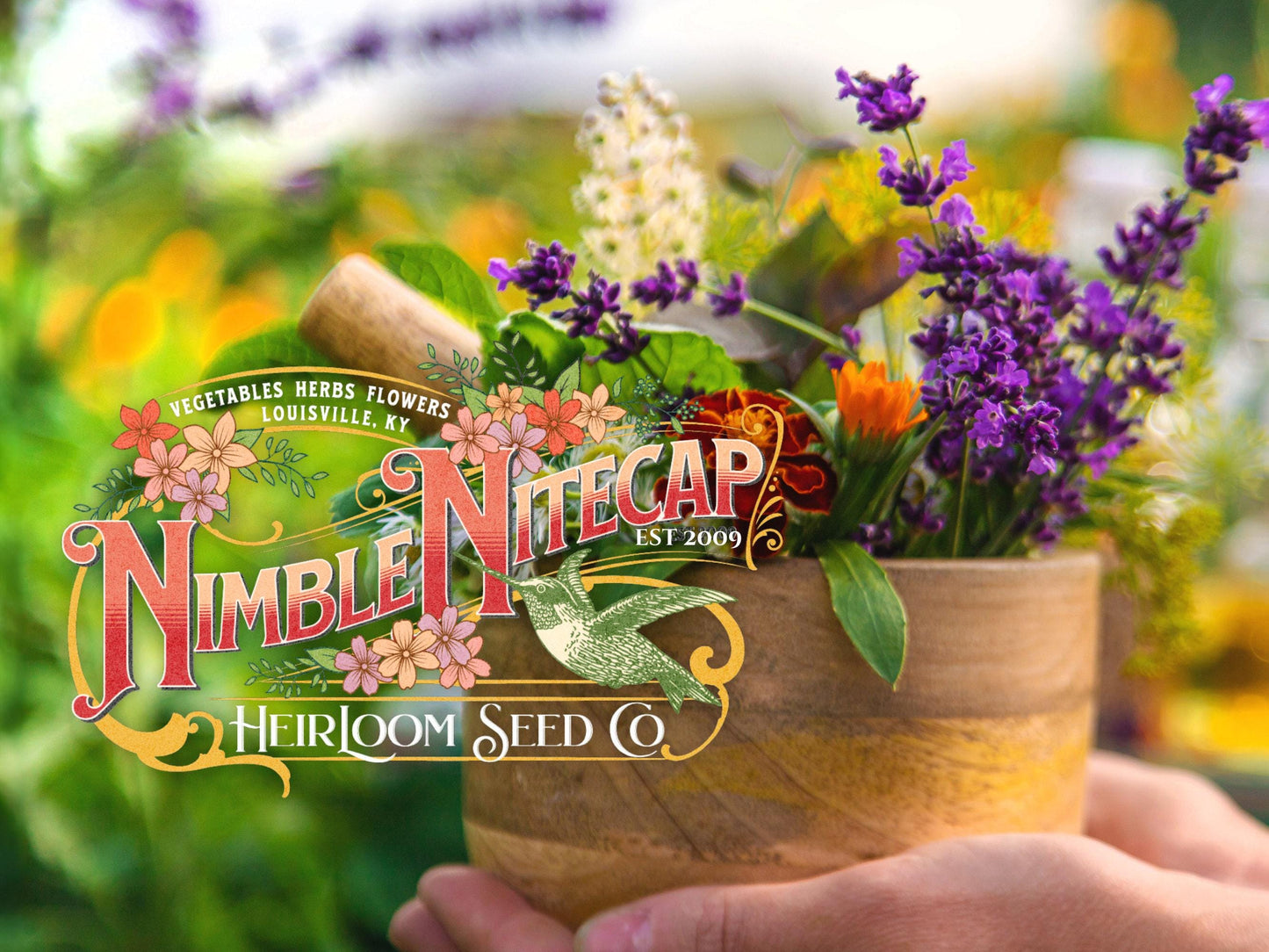Cinnamon Basil is a unique heirloom variety known for its warm, sweet, and slightly spicy flavor with a distinct cinnamon scent. This basil features striking green leaves with dark purple stems and pinkish-purple flower spikes, adding both flavor and beauty to your garden. Commonly used in both culinary and ornamental applications, Cinnamon Basil is perfect for adding a warm, spicy note to teas, desserts, salads, and Asian dishes.
This versatile herb thrives in warm weather, making it an ideal addition to summer gardens and containers. Its eye-catching appearance and aromatic leaves make it a favorite for both chefs and gardeners. Add chopped fresh cinnamon basil to pumpkin pie filling as an alternative to ground, dried cinnamon. Puree cinnamon basil with garlic and olive oil for pesto and use to top fresh pasta.
* SCROLL DOWN FOR DETAILED GROWING INFO *
All Nimble NiteCap Seeds are:
• Heirloom
• Organic
• Non-GMO
• Open Pollinated
• Untreated
• US Grown
• growing instructions included
• Regular testing is conducted to uphold the highest germination standards, all the while employing appropriate seed storage techniques.
Sustainable Packaging & Shipping:
• NimbleNitecap seeds are packed in eco-friendly, compostable seed packets. Seed packets are printed in house with vegetable-based inks on biodegradable, recycled materials. (Small plastic bags are infrequently used to prevent the loss of very small seeds.)
• All orders are carefully packed and shipped with tracking via USPS First Class (or Priority, if selected) in padded ECOENCLOSE recycled and reusable mailers, or recycled boxes to protect your items in transit.
Most orders ship out the same or next business day! Please note that this time may be extended during peak season.
• FREE SHIPPING on all orders of $35 or more. Flat Rate shipping no matter how many packets you order.
* DIRECTIONS *
Common Names: Cinnamon Basil
Latin Name: Ocimum basilicum ‘Cinnamon’
Type: Herb
Life Cycle: Annual
USDA Zones: 9 - 11 (grown as an annual in other zones)
Stratification: Not required
Germination Ease: Easy
Sunlight: Full Sun
Moisture: Prefers consistently moist, well-drained soil
Soil: Rich, well-drained soil with a pH between 6.0 and 7.0
Height: 18-30 inches
Spread: 12-18 inches
Color: Green leaves with dark purple stems and pinkish-purple flowers
Bloom Season: Summer
Companion Plants: Pairs well with tomatoes, peppers, and eggplants. Enhances flavor and repels pests like mosquitoes.
Climate Adaptability: Adaptable to warm climates; does not tolerate frost
~ Sowing ~
When to Start Inside: 6-8 weeks before your average last frost date.
When to Start Outside: Sow seeds directly in the garden after the last frost when the soil has warmed to at least 70°F (21°C).
Planting Depth: Sow seeds ¼ inch deep.
Watering: Keep the soil consistently moist but not waterlogged.
Light and Temperature: Cinnamon Basil prefers full sun and warm temperatures between 70-90°F (21-32°C).
Germination: Seeds typically germinate in 5-10 days.
~ Transplanting Seedlings Outdoors ~
Timing: Transplant seedlings outdoors after the risk of frost has passed and the soil is warm.
Location: Choose a sunny location with well-drained soil.
Spacing: Space plants 12-18 inches apart to allow for adequate growth and air circulation.
Transplanting: Gently transplant seedlings into the prepared soil, ensuring the root ball is covered and the plant is stable. Water well after planting.
~ Growing ~
Watering: Water regularly to keep the soil evenly moist. Mulching can help retain soil moisture and keep roots cool.
Fertilizing: Basil benefits from a balanced fertilizer or compost worked into the soil before planting. A light side-dressing of compost or fertilizer can be applied every few weeks during the growing season.
Pest and Disease Management: Monitor for pests such as aphids, slugs, and spider mites. Use organic pest control methods such as neem oil or insecticidal soap. Ensure good air circulation to prevent fungal diseases.
Maintenance: Pinch off the flower buds to encourage leaf production and prevent the plant from going to seed too early.
~ Harvesting ~
When to Harvest: Harvest leaves as needed, typically 50-60 days after sowing.
How to Harvest: Pinch off individual leaves or cut entire stems just above a leaf node. Harvest regularly to encourage new growth.
Drying and Storing: Basil is best used fresh. For long-term storage, basil leaves can be dried or frozen.
~ Seed Saving ~
Allow one or two plants to flower and produce seeds. Once the seed heads have dried, collect the seeds and store them in a cool, dry place for future planting.
~ Additional Information ~
Forage for Pollinators: Cinnamon Basil flowers are attractive to bees and other pollinators.
Origin: Native to tropical and subtropical regions, this basil variety is commonly used in Mexican and Asian cuisine.
Nomenclature: The genus name "Ocimum" comes from the Greek word for fragrant, reflecting the plant’s aromatic qualities. The species name "basilicum" means royal, highlighting its historical value.
History: Cinnamon Basil has been cultivated for its unique flavor and aromatic qualities, making it a popular choice for both culinary and ornamental purposes.
Climate Adaptability: Thrives in warm climates; best grown as an annual in most regions.













